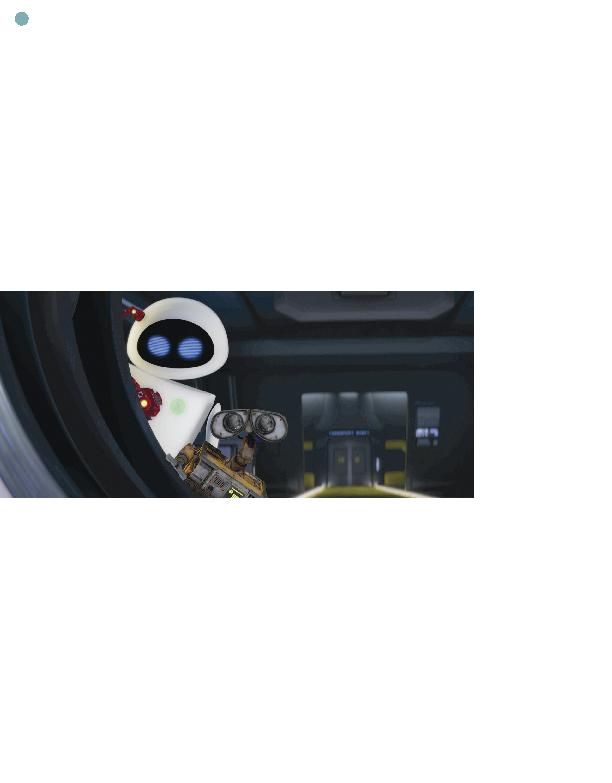
fighting crime -- we feel sorry for him when
the citizens turn on him for the collateral
damage caused from his crime-fighting, start-
ing with a suicidal man who sues Mr. Incred-
ible for saving him from his intentional fall
("You didn't save my life, you ruined my
death!"). This lawsuit creates an avalanche of
other lawsuits, prompting the government to
put all superheroes in a "superhero relocation
program" where they are forced to live nor-
mal lives. So not only do we understand the
pathos of being unjustly accused of some-
thing he didn't do, we also feel sorry for Mr.
Incredible having to live a boring life and sti-
fling his talent because of it.
using the other two devices (humanity and
admiration) also does the trick. But writer be-
main character without pathos, but ignoring
it may ultimately have a negative effect on the
audience's overall satisfaction with the film,
as evidenced by the critical reaction to Pixar's
seventh film Cars, which had the most mixed
reviews of all of the studio's films.
at what he does and is an adored superstar, be-
cause he's cocky about it not once do we feel
any pathos for Lightning McQueen. This
omission strips away the heart that has
proven effective in other Pixar features and
may explain why the film wasn't as successful
critically (it still did well at the box office be-
cause it had heart that was focused on the
theme, not the main character). The key of
connecting emotionally with the main char-
acters is a balance between pathos, humanism
connection, if they want heart, use pathos
first and foremost.
of the main character's motivation; these
stakes should be universal so they resonate
with all audiences. When the stakes are min-
imal or missing altogether, the story becomes
flat, no matter how well the writer tries to
hide it through special effects or quirky dia-
logue. In a recent interview at the San Diego
Comic-Con, Lasseter mentioned how he loves
turning inanimate objects into living charac-
ters, and that his process involves thinking
about what would be that object's main pur-
pose in life -- its reason for "living." As an ex-
ample, he used his water bottle to imagine
what that bottle's main joy in life could be: to
quench the thirst of a drinker. As long as the
worries about the moment it will become
empty and then discarded in a recycling bin.
This is the same with toys: Their sole purpose
is to be played with and nothing is sadder for
them than their owner outgrowing and aban-
doning them. When these stakes are emo-
tional and relatable, the connection with the
main character is strengthened. Keep in mind
that the main character's motivation must be
worthy and selfless for the audience to really
care. Many film failures have showcased char-
acters we cared about through pathos but
whose main motivation was too selfish, hence
the low emotional stakes.
fared as well critically or commercially. The
two films I chose have similar concepts and
characters to show that these were not a fac-
pare rats with rats by profiling Ratatouille
against Flushed Away.
Flushed Away, in collaboration with Dream-
Works, is about a pampered, caged British rat
who struggles to return to his mansion after
being accidentally flushed down the toilet to
the sewer city.
Ratatouille, first through irony -- this is a rat
who wants to be a chef in Paris -- and then
through the trio of empathy techniques in the
emotional core. Starting with our first intro-
duction of Remy the rat crashing through a
window and being chased out of a kitchen by
an old lady, we empathize, as we would with
any character in jeopardy (pathos). Then, with
himself, we get more
pathos and admiration --
he's a rat with a highly de-
veloped sense of smell and
taste. The problem is that
Remy lives in a world
where he must forage for
garbage, though he'd
rather eat fine food. Plus,
he's not appreciated by his
family, as his father uses
Remy's talent to make
him work as the rat poi-
son detector of the clan,
smelling garbage to label it
safe or poisonous.
become a chef. We connect with Remy even
more when we realize he's more intelligent
than the other rats, as evidence by the fact
that he chooses to walk on his hind legs to
keep his front paws clean for eating. He can
also read cookbooks and understand human
speech, his idol is Gusteau the chef, and he
admires humans for their taste in food despite
his father's warnings that humans are dan-
gerous. Despite being a rat, Remy is a culinary
wizard burning with the desire to cook (ad-
miration). He loves his brother, Emil, and
shares with him his secret passion for food.
Not only is Remy excited about cooking, he
teaches Emil to rise above garbage and appre-
ciate good food (humanism).
chimney (admirable cleverness), all he cares